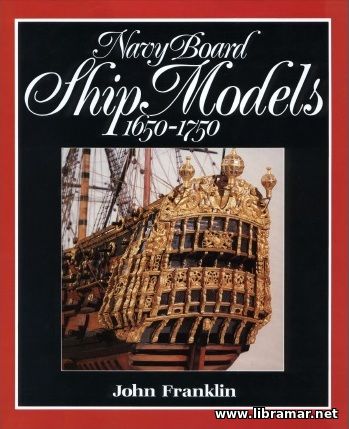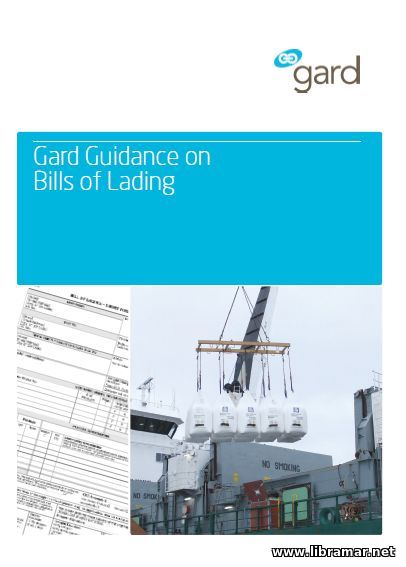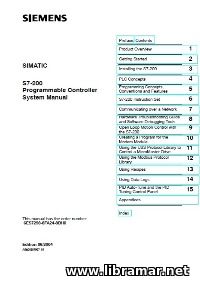Concrete in Shipbuilding
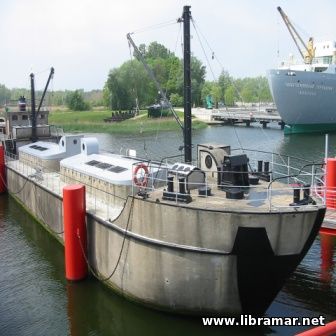
Let us talk a bit more about the application of non-ferrous materials in ship construction. The previous article covered the use of the GRP while in this one we will deal with concrete. Concrete consists of a mixture of stone aggregate bonded by a hardened cement, and Portland cement is normally used for marine applications. The aggregate consists of sand, gravel, and crushed stone. Specific gravity of concrete normally varies between 2.2 and 2.5, primarily depending upon the sizes and density in the stone mixture. Lighter weight concrete with specific gravities in the 1.6 to 2.0 range are made by using clay and shale aggregate. The ratio of water to cement is one of the most significant factors in determining concrete quality and properties.
Ordinary structural concrete with a water/cement/ratio approximating 0.40 by weight is usual for marine work. The long term durability of concrete in sea water has been well established on the basis of service experience and testing of samples from structures that have been submerged. However, in certain situations when concrete is ex¬posed to sulfate in soils or fresh water, it may react with the sulfate, and degrade. Sea water, however, minimizes or prevents such deterioration. Where sulfate deterioration is of concern, special sulfate resistant concretes are used.
Ferrocement
Ferrocement is a form of reinforced concrete wherein layers of steel mesh are used as the reinforcing medium. The material has been used for making small boats up to 50m with skin thickness of 10 mm to 40 mm. The low cost and 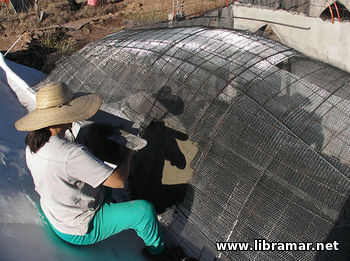 availability of the mesh and concrete ingredients make ferrocement particularly attractive where sophisticated industrial facilities are not available. Its most extensive commercial use has been for fishing vessels up to 50 m in length.
availability of the mesh and concrete ingredients make ferrocement particularly attractive where sophisticated industrial facilities are not available. Its most extensive commercial use has been for fishing vessels up to 50 m in length.
Reinforced Concrete
Reinforced concrete consists of cement reinforced by structural grade steel bars. It is usually used in thicknesses of 90 mm or greater. For applications where loading is in compression the concrete as well as the steel is effective in providing the required compressive strength. However, for ships, where applied loading alternates between tension and compression, the cement provides no significant resistance to the tensile forces; its principal function under such loading condition being to provide a watertight structure.
Despite these limitations, a variety of oceangoing ships, including oil tankers up to 7,500 dwt have been built to classification society rules and successfully operated. Because of the inability of concrete to sustain significant tensile loads, sufficient knowledge of anticipated service stresses coupled with good design are required to avoid exposure of the concrete to service tensile stresses, which induce cracking of the concrete.
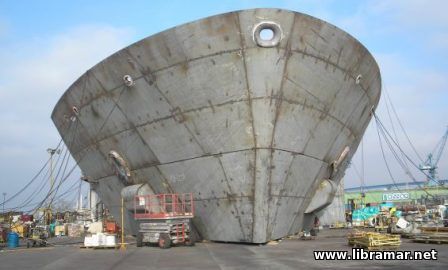 In addition to strength reduction, cracking of concrete enables sea water to reach and initiate corrosive attack on the reinforcing bars; this in turn weakens the bond between cement and reinforcing bar and induces separation of the concrete. With the advent of prestressed concrete, use of reinforced concrete is now only generally considered for such structures as pontoons, floating docks, small ships, in conjunction with prestressed concrete, or in applications where appreciable alternating loading is not anticipated.
In addition to strength reduction, cracking of concrete enables sea water to reach and initiate corrosive attack on the reinforcing bars; this in turn weakens the bond between cement and reinforcing bar and induces separation of the concrete. With the advent of prestressed concrete, use of reinforced concrete is now only generally considered for such structures as pontoons, floating docks, small ships, in conjunction with prestressed concrete, or in applications where appreciable alternating loading is not anticipated.
Prestressed Concrete
In prestressed concrete high strength, up to 2,068 MPa tensile, reinforcing wires which are prestressed well in excess of 862 MPa replace the structural grade bars used in reinforced concrete. When such prestressed wires are embedded in concrete, the resulting effect is to impose a high compressive load on the concrete.
With the application of alternate cyclic loading equivalent to that experienced by a floating structure such as a ship, the force on the concrete will vary from the initial high compression, to a higher compression to a lower compression. Under such conditions the concrete remains in compression with externally applied tensile and bending loads and the threat of cracking of the concrete from tensile loading is eliminated.
Concrete resists imposed shear and compression loads. Prestressed concrete develops several attractive proper¬ties as a result of its heterogeneous prestressed wire/cement structure. Loads imposed locally are dispersed through the structure via the numerous supporting metallic wires, thereby preventing or minimizing damage from concen¬trated shock loads, i.e., the structure is highly resistant to fracture propagation.
The combination of the foregoing, and the relatively heavy thicknesses and large mass associated with prestressed concrete structures make the material an attractive candidate for applications where resistance to shock, collision damage or sudden failure is of concern. Prestressed concrete also has high damping properties which are beneficial in minimizing vibration. The applicability of prestressed concrete to cryogenic applications is well documented by its successful application to liquefied natural gas storage at -160°C. Brittle fracture of the reinforcing wires does not occur at cryogenic temperatures because of the thinness of the wire's cross section, and the supporting concrete matrix.
The relatively thick sections required of reinforced concrete and prestressed concrete structures as compared to steel, are obstacles to their use for many marine applications. In addition, while service experience has been generally satisfactory for the reinforced and prestressed concrete marine structures built to date, extensive service experience and supporting data will be required for some of the more ambitious designs proposed such as a 300 m LNG tanker. Concrete has been successfully used in fixed off¬shore structures and guides for such use are available.
An area of required research pertinent to reinforced and prestressed concrete is the possible corrosion of steel in splash zones. Concrete normally inhibits corrosion of imbedded steel by maintaining an alkaline environment that produces a passivated surface condition. However, at the splash zone, cyclic exposure to oxygen and chloride levels above those of subsurface sea water may lead to corrosion of the reinforcing wires or bars and loss of the synergistic effect of the concrete/steel bonding, this in turn may lead to premature spelling and a need for repair.
In addition, concrete tends to exhibit greater permeability and could become more readily saturated with sea water at the splash zone. This in turn tends to make such areas more susceptible to frost damage. In view of the preceding, it appears, that for some applications, consideration may be required to provide suitable protective covering at the splash zone areas.
The "Read Later" function allows you to add material to this block with just one click. Just click on the icon and read the articles that interest you at any convenient time.
